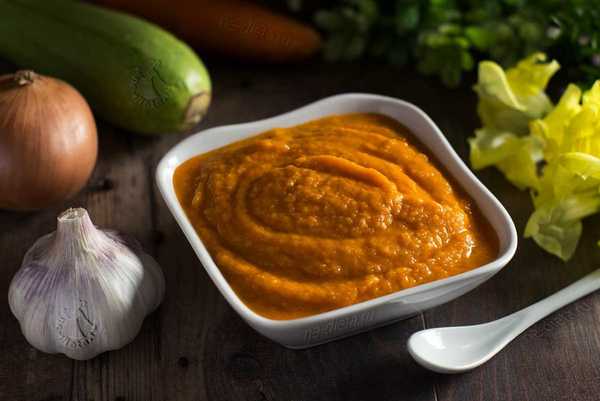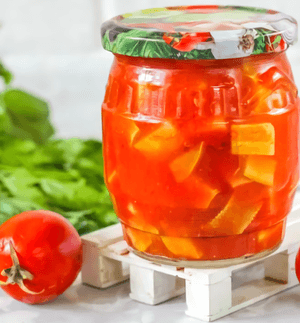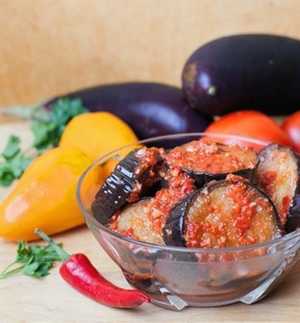Zucchini caviar for winter
Preserve the delicate taste of summer with zucchini caviar for winter! An easy recipe with tips and cooking steps. Add sunny notes to your dishes in cold weather.




Recipe: Zucchini Caviar for Winter
Zucchini caviar is a delicious appetizer that allows you to enjoy the tender taste of zucchinis even in the winter months. It pairs perfectly with bread, toast, and other dishes.
Ingredients
- 1.5 kg zucchinis
- 2-3 large onions
- 3-4 carrots
- 3-4 sweet peppers (optional)
- 4-5 cloves of garlic
- 3 tablespoons of tomato paste
- 100 ml vegetable oil
- Salt and pepper to taste
- Spices: cumin, coriander, paprika (optional)
Cooking Steps
- Wash the zucchinis, peel them (if desired), and cut them into small cubes.
- Finely chop the onion, grate the carrot, and chop the pepper.
- Heat the oil in a deep skillet or pot and sauté the onion until translucent.
- Add the carrot and simmer for a few minutes until soft.
- Add the zucchinis and pepper, simmer until soft and reduce the liquid.
- Add the tomato paste and mix.
- Add the minced garlic, spices, salt, and pepper to taste.
- Simmer the caviar over low heat until you reach the desired consistency and volume.
- Pour the ready caviar into sterilized jars and seal them.
Tips
- For a richer flavor, add a bit of red wine to the caviar before simmering.
- For a spicier caviar, add some chili pepper or red pepper flakes.
- For a richer taste, add some grated cheese, such as parmesan or blue cheese, to the caviar.
- For added aroma and spiciness, add some fresh basil or oregano before jarring the caviar.
- Serve the zucchini caviar cold, but it's also delicious when warmed up before serving.
- This recipe can be varied by adding other vegetables, such as eggplants, tomatoes, or mushrooms.
- To preserve the bright green color of zucchinis, do not overcook them.
- When serving, sprinkle the zucchini caviar with fresh herbs or grated cheese for extra flavor.
- To maintain a coarser texture, leave the zucchinis slightly larger when cutting them.
- Try adding a bit of tahini or sesame paste for a richer taste and texture.
- If caviar turns out too thick, you can thin it out with some vegetable or chicken broth.
- This caviar can be used not only as an appetizer but also as a filling for pies or canapés.
Common Mistakes
- Overdoing it with the tomato paste can overpower the natural taste of zucchinis and vegetables.
- Prolonged simmering over high heat can result in dried out caviar.
- Using overly mature or overripe zucchinis may give the caviar an unwanted mushiness.
- Insufficient simmering of vegetables can leave a raw taste in the caviar.
- Overly intense simmering of vegetables can lead to a loss of their natural texture and color.
- Overdoing it with salt or spices can overshadow the natural taste of vegetables.
- Excessive tomato paste can give the caviar a more acidic taste.
- Ignoring stirring during cooking can result in uneven distribution of flavors and aromas.
- Using unsuitable spices can affect the overall taste balance of the caviar.
- Prolonged storage of caviar in jars with loosely closed lids can lead to product spoilage.
- Using overly soft or overripe vegetables can result in a more cloudy caviar.
- Improper sterilization of jars can lead to spoilage and even health hazards.
Fun Facts
- Zucchini caviar for winter is a great way to recreate the taste of summer even in the coldest months.
- Zucchinis are often used in cooking as a substitute for eggplants to make caviar.
- Zucchini caviar can be a great addition to sandwiches, potato dishes, and appetizers.
- Zucchini caviar is delicious both hot and cold, making it a versatile appetizer.
- In some regions, zucchini caviar is also called "zucchini makhonka."
- In Italian cuisine, a similar dish is called "zucchini caponata" and is often used in pastas and sandwiches.
- Zucchinis are rich in vitamins A and C, as well as fiber, making them a healthy ingredient in the diet.
- Zucchini caviar is a great way to hide vegetables from children and introduce them to new flavor experiences.
- Different colored varieties of zucchinis can be used in the recipe to give the caviar a diverse color palette.
- Zucchini caviar is popular in vegetarian and vegan cuisine as an alternative to traditional caviar.
- Traditionally, vegetable oil is used in the recipe, but you can experiment with olive or coconut oil.
- Zucchini caviar for winter can be a great gift for friends and family, bringing a sunny mood to cold months.
- This recipe is perfect for those who want to enjoy the taste of summer even in winter, while preserving the beneficial properties of vegetables.




